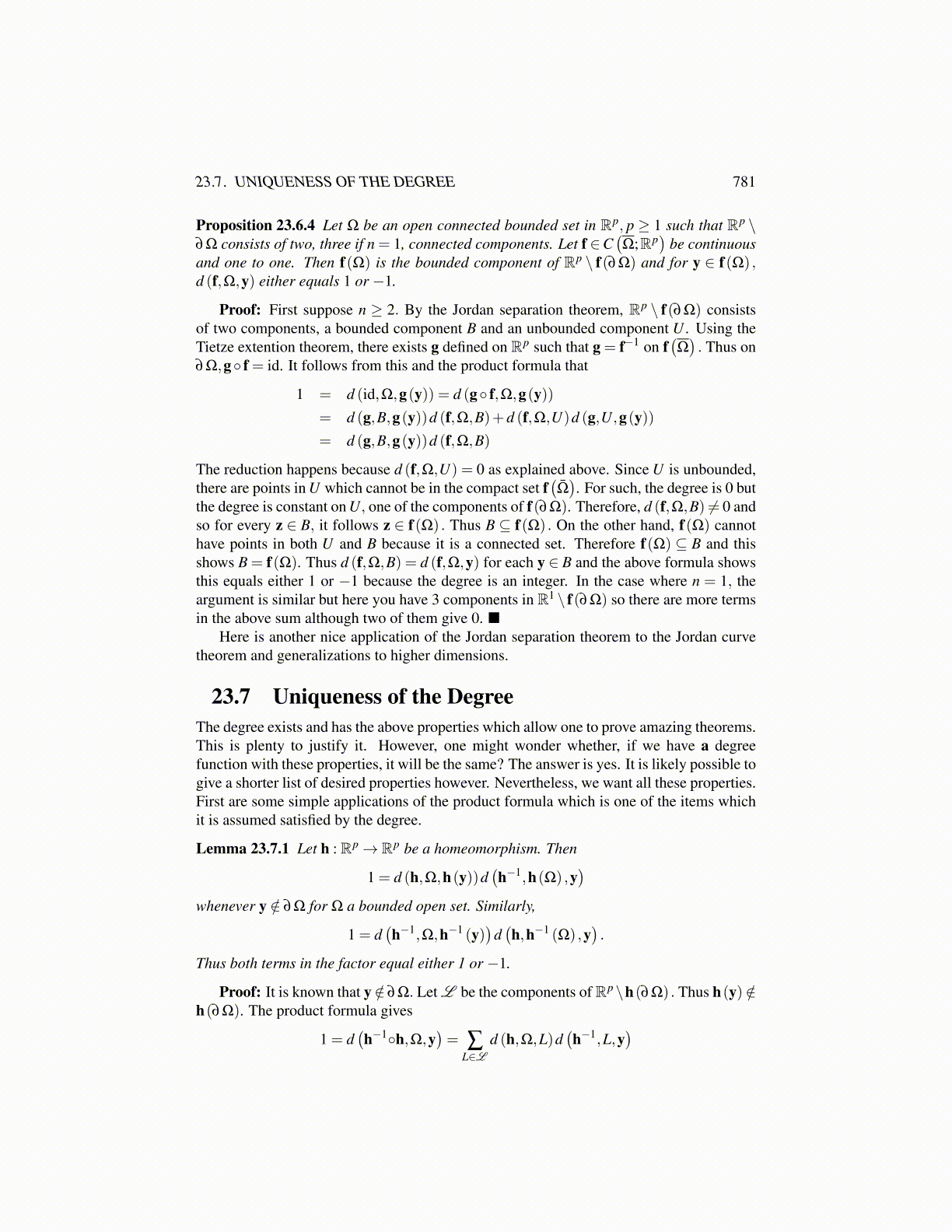
23.7. UNIQUENESS OF THE DEGREE 781
Proposition 23.6.4 Let Ω be an open connected bounded set in Rp, p ≥ 1 such that Rp \∂Ω consists of two, three if n = 1, connected components. Let f ∈C
(Ω;Rp
)be continuous
and one to one. Then f(Ω) is the bounded component of Rp \ f(∂Ω) and for y ∈ f(Ω) ,d (f,Ω,y) either equals 1 or −1.
Proof: First suppose n ≥ 2. By the Jordan separation theorem, Rp \ f(∂Ω) consistsof two components, a bounded component B and an unbounded component U . Using theTietze extention theorem, there exists g defined on Rp such that g = f−1 on f
(Ω). Thus on
∂Ω,g◦ f = id. It follows from this and the product formula that
1 = d (id,Ω,g(y)) = d (g◦ f,Ω,g(y))= d (g,B,g(y))d (f,Ω,B)+d (f,Ω,U)d (g,U,g(y))= d (g,B,g(y))d (f,Ω,B)
The reduction happens because d (f,Ω,U) = 0 as explained above. Since U is unbounded,there are points in U which cannot be in the compact set f
(Ω̄). For such, the degree is 0 but
the degree is constant on U, one of the components of f(∂Ω). Therefore, d (f,Ω,B) ̸= 0 andso for every z ∈ B, it follows z ∈ f(Ω) . Thus B ⊆ f(Ω) . On the other hand, f(Ω) cannothave points in both U and B because it is a connected set. Therefore f(Ω) ⊆ B and thisshows B = f(Ω). Thus d (f,Ω,B) = d (f,Ω,y) for each y ∈ B and the above formula showsthis equals either 1 or −1 because the degree is an integer. In the case where n = 1, theargument is similar but here you have 3 components in R1 \ f(∂Ω) so there are more termsin the above sum although two of them give 0.
Here is another nice application of the Jordan separation theorem to the Jordan curvetheorem and generalizations to higher dimensions.
23.7 Uniqueness of the DegreeThe degree exists and has the above properties which allow one to prove amazing theorems.This is plenty to justify it. However, one might wonder whether, if we have a degreefunction with these properties, it will be the same? The answer is yes. It is likely possible togive a shorter list of desired properties however. Nevertheless, we want all these properties.First are some simple applications of the product formula which is one of the items whichit is assumed satisfied by the degree.
Lemma 23.7.1 Let h : Rp→ Rp be a homeomorphism. Then
1 = d (h,Ω,h(y))d(h−1,h(Ω) ,y
)whenever y /∈ ∂Ω for Ω a bounded open set. Similarly,
1 = d(h−1,Ω,h−1 (y)
)d(h,h−1 (Ω) ,y
).
Thus both terms in the factor equal either 1 or −1.
Proof: It is known that y /∈ ∂Ω. Let L be the components ofRp \h(∂Ω) . Thus h(y) /∈h(∂Ω). The product formula gives
1 = d(h−1◦h,Ω,y
)= ∑
L∈Ld (h,Ω,L)d
(h−1,L,y
)